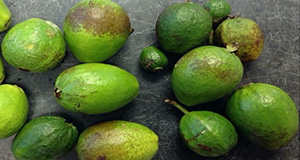Abstract
Guava is a popular subtropical fruit tree grown commercially in south Florida. Production is affected by multiple diseases of different origin. This guide provides information about the most common diseases, including disease biology and management. Written by Romina Gazis, Jonathan Crane, and Jeff Wasielewski, and published by the UF/IFAS Plant Pathology Department, revised April 2024.
References
Alfenas, A. C., E. A. V. Zauza, M. J. Wingfield, J. Roux, and C. M. Glen. 2005. “Heteropyxis natalensis, a New Host of Puccinia psidii Rust.” Australasian Plant Pathology 34 (2): 285–286. https://doi.org/10.1071/AP05023
Alfieri, S., J. Langdon, K. R. Kimbrough, N. E. El-Gholl, and C. Wehlburg. 1994. “Diseases and Disorders of Plants in Florida (Bulletin No. 14).” Florida Department of Agriculture and Consumer Services. Contribution 680:1114.
Ash III, E. C., and E. L. Barnard. 1994. “Mushroom Root Rot.” In Forest and Shade Tree Pests. Division of Forestry. Leaflet 11.
Burnett, H. C., and T. S. Schubert. 1985. “Puccinia psidii on Allspice and Related Plants.” Florida Department of Agriculture and Consumer Services.
Center for Agriculture and Bioscience International (CABI), Plantwise Knowledge Bank (PWKB). Accessed December 4, 2023. https://plantwiseplusknowledgebank.org/
Holliday, P. 1980. Fungus Diseases of Tropical Crops. 147. Cambridge: University Press.
Hossain, M. S., and M. B. Meah. 1992. “Prevalence and Control of Guava Fruit Anthracnose.” International Journal of Pest Management 38 (2): 181–185. https://doi.org/10.1080/09670879209371680
Keith, L. M., M. E. Velasquez, and F. T. Zee. 2006. “Identification and Characterization of Pestalotiopsis spp. Causing Scab Disease of Guava, Psidium guajava, in Hawaii.” Plant Disease 90 (1): 16–23. https://doi.org/10.1094/PD-90-0016
Keith, L. M., and F. T. Zee. 2010. “Guava Diseases in Hawaii and the Characterization of Pestalotiopsis spp. Affecting Guava.” II International Symposium on Guava and Other Myrtaceae 849:269–276. https://doi.org/10.17660/ActaHortic.2010.849.31
Lim, T. K., and B. Q. Manicom. 2003. “Diseases of Guava.” Diseases of Tropical Fruit Crops:275–289. https://doi.org/10.1079/9780851993904.0275
Loope, L., and A. M. La Rosa. 2010. “An Analysis of the Risk of Introduction of Additional Strains of the Rust Puccinia psidii Winter ('Ohi'a Rust) to Hawai'i (No. 2008-1008).” US Geological Survey. https://doi.org/10.3133/ofr20081008
Misra, A. K. 2004. “Guava Diseases—Their Symptoms, Causes and Management.” In Diseases of Fruits and Vegetables: Volume II: Diagnosis and Management. 81–119. Dordrecht: Springer Netherlands. https://doi.org/10.1007/1-4020-2607-2_4
Misra, A. K. 2005. “Present Status of Important Diseases of Guava in India with Special Reference to Wilt.” I International Guava Symposium 735:507–523. https://doi.org/10.17660/ActaHortic.2007.735.68
Misra, A. K. 2007. “Post-Harvest Diseases of Guava and Their Management.” In Biotechnology: Plant Health Management, edited by Neeta Sharma and H. B. Singh. 397–419.
Nelson, S. C. 2008. “Cephaleuros Species, the Plant-Parasitic Green Algae.” University of Hawaii at Manoa, College of Tropical Agriculture and Human Resources, Cooperative Extension Service.
Nogueira Júnior, A. F., I. H. Fischer, C. A. Bragança, N. S. Massola Junior, and L. Amorim. 2016. “Identification of Botryosphaeriaceae Species That Cause Stylar-End Rot of Guavas and Characterization of the Disease Monocycle.” European Journal of Plant Pathology 144:271–287. https://doi.org/10.1007/s10658-015-0765-x
Pandey, R. R., D. K. Arora, and R. C. Dubey. 1997. “Effect of Environmental Conditions and Inoculum Density on Infection of Guava Fruits by Colletotrichum gloeosporioides.” Mycopathologia 137 (3): 165–172. https://doi.org/10.1023/A:1006842801828
Ploetz, R. C., T. K. Lim, J. A. Menge, K. G. Rohrbach, and T. J. Michailides. 2003. “Common Pathogens of Tropical Fruit Crops.” In Diseases of Tropical Fruit Crops. 1–19. Wallingford, UK: CABI Publishing. https://doi.org/10.1079/9780851993904.0001
Prakash, O. M., and B. K. Pandey. 2005. “Current Scenario of Guava Diseases in India and Their Integrated Management.” I International Guava Symposium 735:495–505. https://doi.org/10.17660/ActaHortic.2007.735.67
Rahman, M. A., T. H. Ansari, M. B. Meah, and T. Yoshida. 2003. “Prevalence and Pathogenicity of Guava Anthracnose with Special Emphasis on Varietal Reaction.” Pakistan Journal of Biological Sciences. https://doi.org/10.3923/pjbs.2003.234.241
Rai, J. N. 1956. “Stylar End Rot of the Guava Fruit (Psidium guayava Linn).” Proceedings/Indian Academy of Sciences 43 (1): 55–61. New Delhi: Springer India. https://doi.org/10.1007/BF03050219
Rayachhetry, M. B., T. K. Van, T. D. Center, and M. L. Elliott. 2001. “Host Range of Puccinia psidii, a Potential Biological Control Agent of Melaleuca quinquenervia in Florida.” Biological Control 22 (1): 38–45. https://doi.org/10.1006/bcon.2001.0949
Sanagorski, L., A. Trulock, and J. A. Smith. 2013. “Armillaria Root Rot (Also Known as Mushroom Root Rot, Shoestring Root Rot, Honey Mushroom Rot): ENH1217/EP478, 7/2013.” EDIS 2013 (8). https://doi.org/10.32473/edis-ep478-2013
Sanahuja, G., P. Lopez, A. J. Palmateer, and A. R. Chase. 2018. “Red Rust of Neoregelia Bromeliads Caused by a Parasitic Alga Cephaleuros parasiticus in Florida.” Plant Health Progress 19 (1): 27–33. https://doi.org/10.1094/PHP-11-17-0068-RS

This work is licensed under a Creative Commons Attribution-NonCommercial-NoDerivatives 4.0 International License.
Copyright (c) 2024 UF/IFAS

